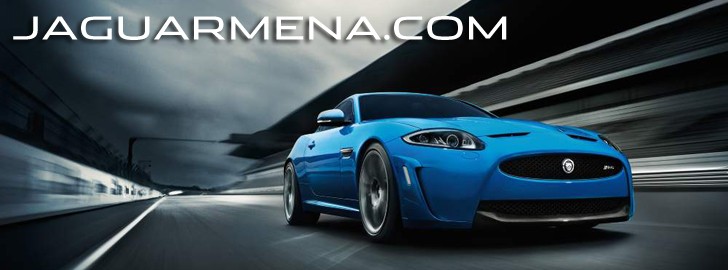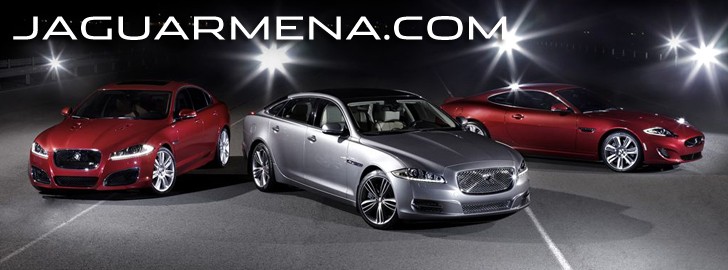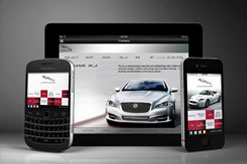F-TYPE | Technology
Active Exhaust
Both the V6 and V8 S models are fitted as standard with an Active Exhaust system (which is optional on the 340PS model). This takes the aural excitement delivered by the F-TYPE to new levels, utilising a number of electronically controlled bypass valves in the rear section of the exhaust which open under hard acceleration to enhance sound quality, effectively altering the exhaust gas routing into a free-flowing straight-through arrangement.
Carefully developed though more than 85 iterations, the Active Exhaust offers an authentic, rich sound, developing to a howling crescendo as the upper limits of the rev range are reached. In addition to the bypass valves opening under load they can be instructed to open full-time by selecting Dynamic Mode using the Jaguar Drive Controller – which also optimises throttle response, gearchange, steering and suspension systems – or via an optional override button.
In order to ensure the driver gains maximum benefit from the system, the acoustic tuning in the rear of the car allows more of the exhaust noise to be heard in the cabin. An Intake Feedback System allows the driver to also experience what is occurring within the intake manifold, which is particularly exciting when combined with the scream of the supercharger spooling up to speed.
Eight-speed ‘Quickshift’ transmission
With eight, closely-stacked, sporting ratios in the ‘Quickshift’ transmission, the F-TYPE driver can fully exploit the rev range and ensure the engine remains within its optimal power band with every gearchange. The transmission has been specifically optimised by Jaguar’s engineers for a sports car application to prioritise acceleration throughout both the rev and speed range.
In order to make every gearshift as connected as possible, the entire drivetrain of the F-TYPE – up to and including tyre contact patches – is tuned for optimal stiffness to allow the transient torque delivery to be made much quicker, meaning the engine responds more keenly and accurately to the demands made by the accelerator. Additionally, once the transmission has shifted into second gear, a locking clutch removes the torque convertor from the equation, creating a direct mechanical link between the engine and the driven rear wheels.
The sense of connectivity extends to the gearchanges themselves, which have been made significantly shorter and more immediate in action – a system known as ‘Quickshift’. This has been achieved via rapid and precisely timed engine torque intervention during upshifts. This creates a much shorter and crisper sounding shift while utilising the engine inertia to deliver a positive acceleration feel for the duration of the gearchange.
The operating parameters of the transmission are determined by the adaptive shift strategy which has 25 different programmes available to it, depending on driving style and road conditions. The transmission can detect the manner in which the car is being driven by monitoring acceleration and braking, cornering forces, throttle and brake pedal activity, road load, kickdown request and even whether the car is being driven up or down hill. On detecting a more urgent driving style, the transmission will automatically make the gearshifts more aggressive and move the shift-up point to higher in the rev range.
The transmission also features a number of functions that specifically relate to the enthusiastic manner in which the F-TYPE will be driven. In order to keep the car balanced during a downshift, the transmission will instruct the engine management system to automatically blip the throttle to match engine revs. This function also allows the transmission to perform multiple and very rapid downshifts during hard braking.
Corner Recognition senses when the car is negotiating a bend, the transmission holding its ratio to ensure the correct gear for the exit. The transmission will also recognise when the car is performing a series of overtaking manoeuvres requiring rapid changes in throttle position and, rather than change up, remain in a lower gear ready for the next demand for acceleration.
Manual override of the transmission is available to the driver at any time, using either the steering wheel-mounted paddles or the central SportShift selector. Moving the selector to the left accesses manual mode in which pushing the lever forward selects a lower gear and pulling it back instructs an upshift. If Dynamic Mode is also selected on the Jaguar Drive Controller, the transmission will not automatically shift up at the redline and will only downshift to prevent engine stalling, leaving control fully in the hands of the driver.
Dynamic Launch Mode
The F-TYPE S uniquely offers one additional feature to optimise acceleration from rest: Dynamic Launch Mode. When the car is stationary, the driver depresses the brake pedal while simultaneously building engine speed until a message reading ‘Dynamic Launch Ready’ appears in the instrument panel. The driver then simply has to release the brake pedal while flooring the throttle and the car will do the rest, optimising acceleration.
Limited-Slip Differentials
A mechanical limited-slip differential is fitted as standard to the F-TYPE S. The mechanical system was chosen for its authenticity and suitability for a rear-wheel drive sports car, offering the driver the opportunity to explore the car’s superb balance and outer limits of its grip within a progressive and tactile handling envelope.
The V8 S model is fitted with Jaguar’s active electronic differential to limit wheelspin, maximise traction and offer even greater control. The Jaguar active differential is operated by an electric motor acting on a multiplate clutch which can transfer torque to the wheel with the most grip. Fully automatic in operation, the system can apply full locking torque almost instantaneously. Working in conjunction with the stability, traction and ABS systems it allows for very fine control of power delivery and always makes the most use of available grip.
Braking
All three variants of the F-TYPE offer progressively more powerful and reassuring braking systems, all with the sporting bite expected of a Jaguar and the high levels of pedal feedback required for accurate modulation.
The Jaguar Performance system fitted to the 340PS F-TYPE has 355mm front and 326mm rear brake discs with silver coloured calipers. The F-TYPE S receives the Jaguar High Performance system gaining larger 380mm brake discs at the front with black or red painted calipers.
The F-TYPE V8 S uses the Super High Performance system with the largest set of brake discs fitted as standard to a Jaguar production car – 380mm front 376mm rear – with black or red painted calipers. All cars are fitted as standard with ABS, Electronic Brake Force Distribution and Emergency Brake Assist.
The use of Computational Fluid Dynamics allowed Jaguar’s engineers to optimise brake cooling, with cold air channelled to the brake discs via the air intakes flanking the grille and by the use of aerodynamically shaped suspension components to direct airflow beneath the car.
Intelligent Stop/Start
For the first time in the MENA region, Jaguar has introduced its Intelligent Stop/Start system which comes as standard with the F-TYPE. Jaguar’s Intelligent Stop/Start system automatically shuts down the engine when the car comes to a halt and the driver’s foot is on the brake pedal. When the brake is released, the system can restart the engine in less time than it takes for the driver’s foot to move from the brake to the accelerator.
The speed of operation of the twin solenoid system also allows for ‘change of mind’ functionality, bringing the engine back up to speed even during its run-down phase if, for instance, the car is coming to a halt at a junction when the driver sees an opportunity to join the traffic flow. The system offers fuel economy and emissions benefits of up to 5 per cent.











